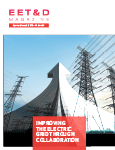
In a few months, we will hit the two-year mark since most of us first heard of COVID-19. Early on, when cities in the U.S. were shut down, many of us weren’t sure how serious the pandemic was or the indiscriminate impact it would have on us or those in our social and professional circles. Was this something that would unite all of us, or would we see a further division between those who called the virus a hoax and those who took it seriously?
This issue of EET&D offers insight into a variety of challenges that have become commonplace in our industry – partly because of the pandemic, and partly because ours is an industry of constant change where electric power providers must always be ready to respond in the event of power outages or any other time the electric grid is disrupted.
In his article, “Weather the Storm with the Right Data,” Mike McGann, vice president of Sensus Americas Global Engineering and Assessment Services, likens utility workers to disaster heroes in the communities they serve. The comparison makes sense because when a storm or other catastrophe strikes, utility workers are among the first responders. They may not arrive on the scene of a disaster with medical equipment, but they are among the first to show up and immediately get to work, troubleshooting how best to protect or restore the grid. By working non-stop in their pursuit of stabilizing the grid, utilities make it possible for people to attend to basic needs like staying warm or cooling off, heating, refrigerating and preserving food or having access to running water.
McGann points out that the heroic endeavors of utility workers often mean that while those workers are safeguarding or restoring our power, their families and homes are among those being impacted by whatever natural or human-caused disaster has affected the grid.
As TRUCE Software CEO Joe Boyle touches on in his article on how utilities can empower their workforce, service providers today encounter more natural disasters, and those disasters are hitting more frequently. He goes on to explain that utilities must figure out how to “manage distributed generation and maintain service while integrating diverse, often sporadic input from renewable sources.” This only compounds the demands placed on electric industry workers.
Facing ongoing extreme weather events like hurricanes and other natural disasters, frontline workers in the electric power industry must be ready to jump into action at any time. Given the increase in extreme weather and other incidents that can take out the power grid, utility workers are working more hours than ever before. Longer hours on the job mean the workers have less time to tend to personal business.
For utility workers to ”save the day” and bring the grid back online, they need the proper skills and tools. When it comes to restoring the power grid, one of the most important tools for utility workers is access to mobile technology. A national workforce survey that TRUCE conducted in January of this year found that 36% of respondents use their mobile devices more now than they did a year ago, and these devices have helped make the workers more productive.
With workers spending more time in the field, they may not have time during “normal business hours” to pay bills, communicate with family members or call customer support with questions like returning a retail item or contesting a charge they don’t recognize on an invoice. Boyle discusses how utilities can empower their workers with mobile technology that would allow them to do their work, while also being able to tend to personal tasks. To accomplish this, utilities must change their archaic mobile device policies.
Boyle addresses some of the obstacles utilities face when establishing policies for how and when their workers can use their mobile devices for both personal and job-related communications. He also explains that the days of strict policies banning employees from using their mobile devices to access the internet or specific applications are over. Today, utilities must implement an effective mobile device policy, but Boyle emphasizes that first, utilities must see their workers as “dynamic rather than static, and then adapt their mobile device policies to uphold that principle.”
Increasing diversity
If the work-life balance was difficult to find pre-pandemic, it is even more so today, and that can leave everyone from C-level executives to the administrative support staff feeling depleted. But, despite this being an era, where more demands are placed on those who work in electric energy, some believe this is a promising time for our industry.
For this issue’s “Powherful Forces” column, we profiled Nooshin Behroyan, founder and CEO of Paxon Engineering and Infrastructure. As she told me about how she got into the energy sector, Behroyan did not spend time rehashing the challenges she has had to overcome because she’s a woman or a Person of Color, who immigrated to this country and established a consulting firm in a male-dominated industry. Instead, she spoke enthusiastically about her career. She also shared her optimism about the shift that employers throughout the U.S. are making towards a more diverse workforce, and why that shift is necessary.
“I think that this is a great time for the country,” Behroyan said. “I applaud the utilities who are making an effort to be more inclusive, but a lot of that comes with the changes happening at the executive level, and if you don’t make those changes, your company’s going to stay behind.”
Behroyan is not one to sit by passively or accept the status quo. She also knows how to pick her battles. For example, early in her career and armed with a bachelor’s degree in architecture, Behoryan was at a construction site for her firm, where she did not agree with the structural engineer about his approach. Rather than letting the disagreement intimidate her or leave her feeling powerless and resentful, Behroyan went back to school and received a master’s in environmental and structural engineering.
As we move closer to 2022, the future of the power industry and the individuals who work in electric energy will remain uncertain, but Behroyan is right This is an exciting time for our country and our industry – as long as we recognize the enormous amounts of time and effort workers are putting into power restoration while ensuring they have the emotional, technological and financial support they deserve for continuously safeguarding the electric grid from any impending disasters.
If you would like to contribute an article or if you have an idea about interesting technology, solutions, or suggestions, please email me at: Elisabeth@ElectricEnergyOnline.com
Elisabeth







